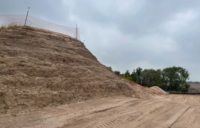The failure of the Middle River levee near Stockton June 3 submerged over 12,000 acres of farmland in up to 20 ft of water. The San Joaquin County Office of Emergency Services estimates $93.7 million in damage to crops, buildings, and levees, including $48.7 million for repairs, restoration and dewatering. President Bush declared a federal disaster on June 30.
Functioning like dams, the levees protect land located at or below sea level, says Curt Schmutte, chief of levees and the North Delta Branch, California Department of Water Resources. Complicating maintenance, the levees were originally constructed without compaction or drainage. Many rest on peat foundations subject to deformation that, in turn, causes the levees to settle and deform. "Unfortunately were engineering structures over the top of non-engineered structures," Schmutte says. More than 150 levee failures in the Delta have been recorded since 1900.
Schmutte attributes last months failure to piping, the erosion of levee material from the interior as water flows through a crack along a path of least resistance. Although the underlying cause will never be known, "A lot of fingers point toward some kind of rodent activity," Schmutte says.
Richard W. Johnson, an attorney and secretary of the local reclamation district that maintains the levee, says the break occurred along "a very well-maintained section . . . were just flabbergasted that we have a loss there."
|
Immediately after the break, Ford Construction Co., Lodi, Calif., placed 52,000 cu yd of material along 13,000 linear ft of nearby levees, raising their elevation to 6 ft above sea level, says Fred Paulsen, Fords district engineer. Crews from the California Conservation Corps and Dept. of Forestry and Fire Protection inmate crews placed sandbags and plastic sheeting on unprotected levees.
By June 5, The Dutra Group, San Rafael, started barging more than 200,000 tons of rock from its local quarry. Placing rock by crane or releasing it from the barge bottom, Dutra built up a roughly pyramidal barrier 40 ft tall and over 100 ft wide at the toe. Low winds and dry weather aided Dutras efforts, says Don Strickland, a spokesman for the Department of Water Resources. A department official estimates the value of Dutras lump-sum contract at $7.5 million to $8 million, based on the unit weight of rock and mobilization/demobilization costs.
This month, Ford Construction will begin pumping out an estimated 130,000 acre-ft of water under a $3.9-million contract, says Paulsen. Low-head hydraulic drive pumps operating around the clock will pump up to 40,000 gals per minute. Water will be discharged into Middle River through 225-ft-long sections of 42-in.-dia. pipeline. The target completion date is mid-October"a fast timeline, but it can be done," Paulsen says.
fter a 25-day, round-the-clock effort, a contractor plugged a nearly 400-ft-wide gap in a failed northern California levee June 30, beating the projected completion date by as much as 20 days. The failure underscores the fragility of 1,100 miles of levees in the San Joaquin Delta, and months of dewatering are expected to begin about July 11.

Post a comment to this article
Report Abusive Comment